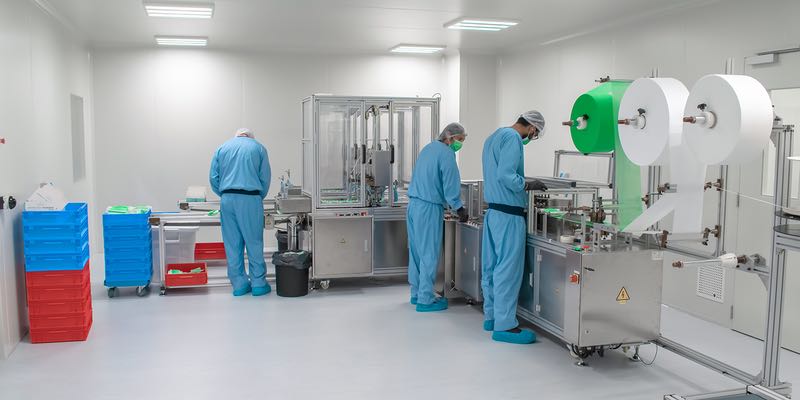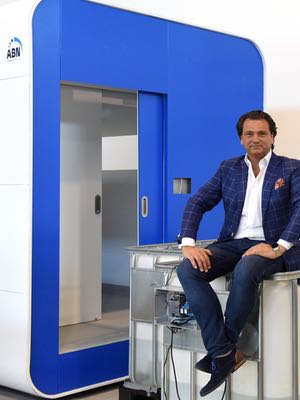CEO of Belgium-based ABN Clean Technology, Jo Nelissen, helped found the company in 1996 and since then has played a big part of its expansion and innovation.
He wears many hats in the company operation. "I love being active in the Sales & Marketing division of ABN Cleanroom Technology. Apart from that, our innovation department is where I feel completely at ease."
Nelissen says leadership is much more than just running a company and having your sales team sell pre-engineered cleanroom solutions. It is about achieving the highest purposes with your team. "You can't imagine how proud I am of all the people in my cleanroom team when they've come up with a new, innovative solution," he enthuses.
A particular moment of pride came for Nelissen when a customer requested a cleanroom that could be moved to another location after a couple of months. "With that requirement in mind, we contacted a local supplier of mobile units, like the container units you see at festivals," he explains. Together, the two created a whole new concept where ABN Cleanroom Technology transformed a movable 'container' unit into a full cleanroom equipped with a PALL, MALL and classified production area ISO Class 6 or ISO Class 7.
"For me, it is one of the greatest examples of thinking our-of-the-box and being creative with what's available on the market," Nelissen reflects. "We got so many great responses to that development, so we decided to commercialise this product under the name 'SteriCube' and place it in the market for buying as well as renting purposes. Ever since our SteriCube has been one of our most successful modular products that resulted from a project."
Cleanroom demolition should be considered at the design phase
Modularity is the starting point to help companies to enable cleanroom technology with 'modular' meaning scalable, flexible and agile. Nelissen thinks this modern technology can play a key when reliable predicting the budget of a project. "In general, budgeting a project is quite easy as a result of VIX, our pre-engineered and modular cleanroom design concept. We have our pre-engineered building blocks with embedded intelligence to reduce project risk, we like to call it our 'Lego-blocks'," Nelissen explains.
"We believe that a Lego block can be seen as a metaphor for the smallest standardised component that is used as a building block," he adds. "Cleanrooms can't these days be looked at as something static or changeless. They need to evolve over time and the modification cost can be reduced significantly due to their modular design. So the degree of required scalability, flexibility and reliability influences the budget of a project."
Nelissen believes that ABN has a relatively unique approach in the field of cleanroom technology. "Generally speaking, cleanroom companies tend to offer quite conservative solutions, every project starting from scratch, everything completely tailor-made," he says. "And mostly, offering only design and build of the cleanroom. This often leads to significant delivery times, high costs etc. Moreover, traditional cleanroom projects come with a much higher project risk because a lot of the thinking must be performed on-site."
Taking it a step further
Thinking of growing practices in the cleanroom sector, Nelissen thinks a 'configure-to-order' strategy is now disrupting the world. "We are currently living in a world where the 'now' experience is extremely important and has become the new standard. Even in the field of cleanroom technology," he says.
"Up until recently, we, and many cleanroom technology companies still do, operated in an Engineer to Order (ETO) model, leading to higher delivery times. In order to cut delivery times significantly, we decided to make a pre-engineered product family available in a Configure to Order (CTO) model."
Many companies are moving from the linear “take, make, dispose” model towards the circular model
Nelissen explains that ETO is time-consuming and a lot of pressure is put on the engineering department. This approach definitely has its disadvantages: the calculation proceedings last a while and it takes weeks, if not months, for the engineering department to finish up. He contrasts this with CTO, and on the contrary, it is much better suited for today's rapidly changing needs in cleanroom technology. "[CTO] reduces much of the workload from the engineering department and contributes to the supply chain management within a manufacturing company," Nelissen adds. "After all, the purchasing department and production department can get started as soon as they receive the order. Moreover, by decreasing the workload on the engineering department, new space is created for innovation."
Change the world
Modularity is not the only futuristic technology that Nelissen is in support of. He thinks there is much that needs to be done with CFD modelling. "Comprehensive analysis of Computational Fluid Dynamics (CFD) predicts airflow dynamics, meaning that this dynamic digital twin model prevents less efficient airflow in a cleanroom," he explains.
Nelissen gives the practical example: "A dynamic simulation of our decentralised VIX air recirculation concept ensures an optimum airflow in a classified space. It optimises the Air Change Effectiveness (ACE) index to achieve perfect air mixing of the entire cleanroom. This is so important in the cleanroom industry. A digital twin allows the entire cleanroom industry to simulate dynamic airflow patterns during night setback operations, but it also enables a reduction of the recovery time in a PAL by dynamically changing the Air Change Rate when entering the PAL."

This only enforces another tenant that Nelissen is focused on; sustainability. "To improve the eco- friendliness of cleanroom construction, we hold on to the concept of circular thinking and the demolition phase of a cleanroom," Nelissen says with passion. "Many companies are moving from the linear 'take, make, dispose' model towards the circular model, however, not all of them are active in the field of cleanroom technology."
Nelissen explains that still, too many cleanroom suppliers don't care about what happens with their cleanroom after the construction phase. But, eco-friendliness all depends on the design of your cleanroom and consequently on how well you deal with the demolition of your cleanroom. "The demolition of your cleanroom should be taken into account at the design phase," he says.
The CEO explains that maintaining a circular model means re-using knowledge, data and materials (so-called tangible and intangible 'building blocks' to enable modular thinking). Circularity in cleanroom concepts facilitates a 'use it when you need it' thinking.
"Due to constant connectivity with the cleanroom, it becomes possible to gather data about the efficiency and use of the cleanroom, and to act immediately when something occurs," Nelissen makes the point. "We can therefore point out the life cycle of the asset, but more importantly, change over to a higher life cycle optimisation. Then, later on, the asset can be 'upcycled' to other projects." Nelissen reinforces that sustainability is such an important characteristic of modularity, more specifically because as many components as possible can be reused in a new 'life' with a minimum of energy.
The year 2020
This year has been full of ups and downs for all, and Nelissen things there is an opportunity here. Starting with the good, In February, the new
GMP Annex 1 draft was released. Nelissen said: "GMP Annex 1 is the official directive of the European Union and the problems it wants to tackle are universal. With the new update, the range of products covered by Annex 1 is significantly extended, which creates more opportunities for us." However, he asks what does this mean for cleanrooms?
"In my opinion, in order to achieve a compliant finish of the project, regulations like GMP are all about document management," Nelissen says. "Involving the authorities in a design phase is a good thing."

Next onto the bad. "The year 2020 is one where COVID-19 has been in the spotlight, unfortunately," Nelissen says. Seeing the silver lining, he explains that never has the request for classified spaces and HEPA filtration units been higher (in all areas, from pharma to hospitals). But particularly hospitals in Belgium were in great need of mobile filtration units which we could deliver even the same day as the order came in.
"2020 will be overshadowed by COVID-19, but we're sincerely proud that we could realise some amazing projects to support companies producing protection materials," Nelissen enthuses. "We have for example built a brand new ISO Class 8 cleanroom for the production of mouth masks only within 32 days after receiving the order because the request for producing mouth masks was so enormously urgent."
Nelissen seems to be well aware of the tight turnarounds demanded by this pandemic for a variety of applications. "We also came up with this product called 'CleanTunnel': a fabric-based modular cleanroom solution and perfect for the production of mouth masks to compete against COVID-19," he tells Cleanroom Technology.
Concerning the trends of cleanrooms in 2020, Nelissen says: "We noticed an increasing request for mobile HEPA H14 filtration units to assist hospitals in times of the pandemic. Other than that, we realised some highly innovative Design- Build-Validate-Maintenance projects." He adds that this means luckily, the impact on ABN's cleanroom technology department was kept to a minimum.
For the wider pharma industry, Nelissen is seeing increasing trends in ATMPs and the convergence of nano-electronics and pharmaceuticals, which can require some unique approaches to cleanroom design. He also notes that the requirements are becoming increasingly stringent. "To meet rapidly changing needs in the pharma industry, they are more than ever, evolving towards a modular cleanroom approach," Nelissen urges. "The pharma industry is a great example of companies where needs change over time: today, a small dimensioned cleanroom is required, next week it must be enlarged due to temporarily increasing business, like the pandemic."

